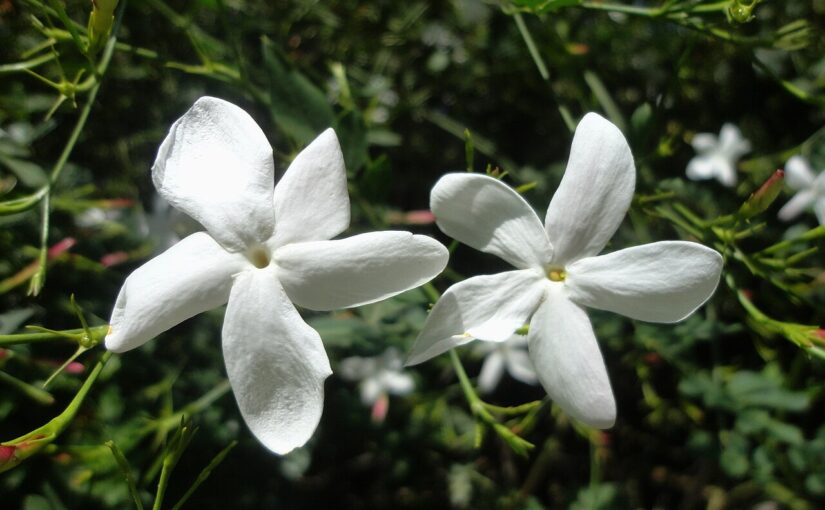Jasmine essential oil, often called the queen of oils, comes from species like Jasminum grandiflorum, Jasminum sambac, and Jasminum officinale, all part of the Oleaceae family. Native to the tropical and subtropical areas of Asia, including northern India, Pakistan, and the northwest Himalayas, jasmine also grows in parts of Africa and Europe. Cultivation now spans Mediterranean countries such as France, Italy, and Spain, along with Morocco, Egypt, China, Japan, Algeria, Turkey, and the United States. The oil, typically an absolute, is produced mainly in France through solvent or CO2 extraction from handpicked flowers, a labor-intensive process that captures its essence.
The aroma is rich, sweet, and intensely floral, with ethereal warmth, balsamic depth, fruity hints, and subtle tea-like notes. It serves as a middle-to-base note in blends. The absolute appears as a dark orangish-brown to pale yellow or rich amber viscous liquid. Key constituents include benzyl acetate at 15 to 25 percent, benzyl benzoate at 8 to 20 percent, linalool at 3 to 12 percent, phytol at 3 to 13 percent, indole at 0.5 to 4 percent, cis-jasmone, and geranyl linalool. These compounds drive its therapeutic and sensory qualities.
Historical and Cultural Significance
Jasmine has been cherished for centuries across India, China, and Arabia, where its intoxicating scent featured in ceremonies and rituals. Immortalized in iconic perfumes like Chanel No. 5, it symbolizes romance and divinity. In Pakistan, it is the national flower, while in Thailand, it represents motherhood. The night-blooming flowers are harvested at dawn for peak fragrance, evoking moonlit gardens and spiritual connection. Known as the oil of flowers, jasmine’s roots in Himalayan cultivation have made it a staple in aromatherapy, uplifting emotions and fostering passion.
Therapeutic Benefits
Jasmine essential oil offers a range of calming and restorative effects, making it a luxurious choice for holistic care. As an antidepressant and sedative, it soothes anxiety, depression, postpartum blues, and insomnia through GABA-calming compounds that elevate mood and build confidence. Its aphrodisiac nature enhances libido, addresses impotence, and counters sexual frigidity, adding a sensual dimension to its profile.
The oil acts as an antispasmodic and analgesic, providing relief from menstrual cramps, labor pains, and bronchial spasms. It functions as an emmenagogue and parturient, stimulating contractions during childbirth and easing premenstrual syndrome symptoms, though it should be avoided during pregnancy. Post-delivery, its lactogenic properties support breast milk production. As a cicatrizant, jasmine heals scars, stretch marks, and skin irritations, while its expectorant action clears coughs, congestion, and asthma symptoms.
Additional benefits include anti-inflammatory and antiseptic effects that soothe skin inflammation and aid minor wound healing. It may also exhibit anticarcinogenic potential by inhibiting estrogen-related conditions, such as enlarged prostate. Benzyl acetate and linalool contribute to its sedative, antispasmodic, and mood-enhancing powers, positioning jasmine as a multifaceted sensual healer.
Aromatherapy Applications
Incorporating jasmine into daily routines is simple yet potent. For diffusion, add five to six drops to a diffuser with 100 milliliters of water to create a romantic or calming environment. Blending with bergamot adds balance. Soften the viscous absolute in warm water for 15 minutes before use. Topically, dilute one to two drops in 30 milliliters of carrier oil like jojoba for sensual massages that ease cramps or boost mood. Apply to temples, neck, or wrists for confidence, keeping dilution at 1 percent to prevent sensitization.
In baths, mix three to five drops with a dispersant in warm water for stress relief, premenstrual syndrome support, or respiratory ease. Inhalation involves one to two drops on a tissue to quickly calm anxiety or enhance mood. Due to its cost and potency, use jasmine sparingly to avoid headaches. It is phototoxic, so limit sun exposure to less than 12 hours after topical application exceeding 1 percent dilution.
Emotional and Energetic Effects
Jasmine’s heady floral scent dissolves fear, anxiety, and low self-esteem, replacing them with euphoria and self-assurance. It ignites passion and deepens spiritual connections, releasing emotional blockages for greater openness. Linked to the sacral and solar plexus chakras, its yin-yang balance and water-fire elements harmonize sensuality with vitality. This makes it perfect for romantic rituals, meditation, or simply embracing a starlit garden’s serenity.
The oil addresses anxiety, depression, low confidence, emotional inhibition, and fear, fostering a sense of empowerment and joy.
Blending and Companion Oils
Jasmine blends seamlessly with bergamot, clary sage, cypress, frankincense, grapefruit, lavender, lemon, lime, mandarin, orange, palmarosa, petitgrain, rose, rosewood, sandalwood, and other floral or citrus oils. Companion choices like sandalwood, rose, patchouli, frankincense, and bergamot enhance its depth. For similar calming and antispasmodic effects, substitutes include clary sage, helichrysum, or nutmeg.
Safety and Precautions
Avoid jasmine during pregnancy because of its emmenagogue and parturient effects, but it is safe afterward for lactation or postpartum depression support. Limit topical dilution to 1 percent to prevent phototoxicity, and avoid sun exposure for 12 hours after application. Patch test for sensitization, especially if prone to fragrance allergies. Heavy use may lead to headaches or drowsiness, so refrain from it before driving or operating machinery. Store in a dark glass bottle in a cool, dark place; shelf life is four to six years if unoxidized. Use externally only, and do not ingest without professional guidance.
Jasmine’s Sensual Bloom
Jasmine essential oil captures the essence of a midnight-blooming flower, offering solace from stress and a spark of passion. From ancient Asian ceremonies to modern wellness, it eases labor pains, lifts spirits, and mends skin with its precious absolute. Diffused for romance or massaged for relief, jasmine embodies fragrant wisdom, inviting users to embrace love in every drop.
Image: Jasminum grandiflorum (Oleaceae) by Juan Carlos Fonseca Mata.
If your heart finds joy and inspiration here, consider supporting the work that keeps these stories blooming. Your donation, no matter the size, helps sustain authentic research, creative writing, and the spirit of sharing that connects us all.
